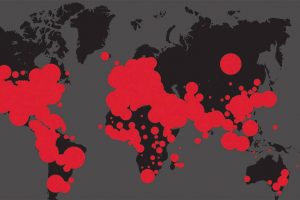
The following was originally published on The Hub.
One year has passed since experts from Johns Hopkins University began tracking the coronavirus pandemic that continues to bring pain and suffering to all corners of the world. The data collected over the past 12 months tell a grim story: COVID-19 has killed more than 2 million people around the world and infected more than 97 million. The toll has been most devastating in the United States: 410,383 dead, 25 million infected.
On Jan. 22, 2020, two people—a civil and systems engineering professor and her graduate student—started a global map to track an epidemic that at the time appeared to be confined to a single nation. Today, a team of more than two dozen scientists, researchers, professors, staff, and students from five Johns Hopkins divisions volunteer their time and expertise to furnish the Coronavirus Resource Center with real-time reliable data and sound expert analysis to track, understand, and combat the virus.
“It has been our highest honor to create this tool that has been relied on by the public and policy makers across the globe,” said Lauren Gardner, co-director of the Center for Systems Science and Engineering. “We all hope to see a day when this vital service is no longer needed, but until then we remain steadfast in our commitment to open data and providing the world with the most accurate and up to date information on this pandemic.”
After Johns Hopkins launched Gardner’s global COVID-19 Dashboard last year, immense international demand for such information quickly led it to become the leading source of centralized data on the pandemic. As the threat from COVID-19 spread, the university expanded that effort into the Coronavirus Resource Center on March 3, harnessing expertise from across the university to aggregate and analyze the best pandemic data available. The Coronavirus Resource Center is made possible through support from Bloomberg Philanthropies and the Stavros Niarchos Foundation.
“We have all put in countless hours and many long nights and weekends building and improving this site as the pandemic has advanced,” said Beth Blauer, executive director of the Johns Hopkins Centers for Civic Impact who oversees U.S. data and visualizations for the CRC. “But behind every data point is a reminder of the toil that medical providers have endured risking their lives every day, the struggle survivors have felt rebuilding their health, and the unbearable loss that too many families continue to experience.”
National publications such as The Washington Post, The Wall Street Journal, and NPR—all of which have cited the center’s data daily for the past year—acknowledged that the resource filled a gap in public health knowledge that the public needed and wanted. TIME in November named the Coronavirus Resource Center to its list of 2020’s Best Inventions, calling it “2020’s Go-To Data Source.” By early January, the site had amassed a billion page views—a tragic testament to the pandemic’s deadly recalcitrance and the ongoing demand for the “evidence-based analysis that shapes sound policy and saves lives,” as JHU President Ronald J. Daniels said at the time.
“It has been truly remarkable to see this diverse, women-led, and interdisciplinary team from all corners of Johns Hopkins University and Medicine come together to build the CRC over the past year,” said Lainie Rutkow, professor in the Bloomberg School of Public Health and senior adviser to Daniels. “All of us who work on the Coronavirus Resource Center feel incredibly grateful to be part of the embodiment of our university’s mission: ‘Knowledge for the World.'”